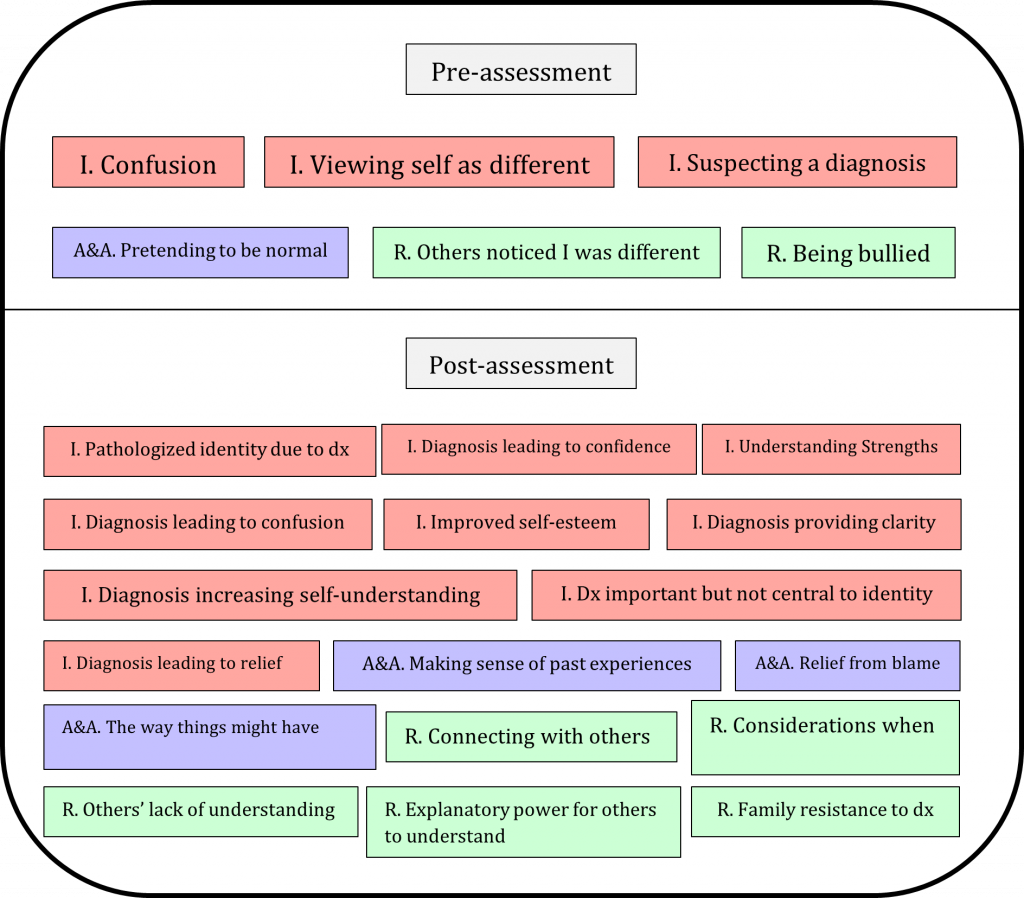Autism Spectrum Dysfunction (ASD) is a lifelong situation characterised by vital difficulties in social communication and interplay. Moreover, these identified with ASD steadily show restricted and repetitive patterns of behaviours and variations in sensory processing (Martinez et al., 2024; Symons, 2021).
In current many years, rising consciousness has helped many people to recognise these behaviours and experiences in themselves and the people round them (Kiehl et al., 2024). This growing consciousness might clarify why there was a considerable enhance within the fee of individuals identified with ASD in the UK (Lorenz, 2022).
Analysis has advised that an ASD analysis can have an effect on a person’s identification, wellbeing, and entry to assist (Kiehl et al., 2024). Nonetheless, various factors (e.g., feeling revered, being concerned throughout the diagnostic course of, and a consideration of gender variations) have been discovered to impression the experiences of those that are receiving an ASD analysis in maturity (Sandell et al., 2013; Hull & Mandy, 2017).
Till just lately, no synthesis of present qualitative analysis on the experiences of adults identified with ASD had been accomplished. This modified with the work of Kiehl et al. (2024), a group of researchers who got down to compile present qualitative information in hope of making a visible illustration of an grownup’s journey from pre- to post-ASD analysis.

This qualitative meta-synthesis aimed to raised perceive, discover, and synthesise the lived experiences of people identified with autism in maturity.
Strategies
Analysis inside this evaluate explored “grownup ([18+]) service-user experiences of the ASD diagnostic course of”. The researchers used their search technique to search out analysis from PsycINFO, Embase, MEDLINE, and CINAHL .
Included analysis consisted of analysis papers, guide chapters, dissertations, and doctoral theses that have been revealed between 4th January 1999 and third January 2022. Eligible analysis was required to incorporate a proper qualitative part of their evaluation. To take care of high quality, all research needed to meet the primary two standards of the CASP scoring system. These standards being, “Was there a transparent assertion of the goals of the analysis?” and “Is a qualitative methodology acceptable?” (Oxford Centre for Triple Worth Healthcare, n.d). No additional high quality appraisal was performed throughout this analysis. To incorporate a spread of lived experiences, those that self-identified as autistic (with no formal analysis) and people research that didn’t report a selected technique of analysis have been thought of eligible.
Reference lists from included analysis papers have been hand-searched for additional eligible analysis. Two reviewers screened titles, abstracts, and full texts independently. The primary 50 titles and abstracts have been screened by a 3rd reviewer. 94% settlement consensus was established.
Reoccurring themes have been recognized by thematic evaluation (Braun & Clarke, 2006) and thematic synthesis (Thomas & Harden, 2008). The Enhancing transparency in reporting the synthesis of qualitative analysis (ENTREC) assertion was referred to when reporting the qualitative synthesis.
Outcomes
24 research, revealed between 2001 and 2021, met the inclusion standards. Many of the research have been performed in both the UK, Australia, United States of America, or Sweden. Researchers utilised a spread of various methodologies, together with semi-structured interviews, different forms of interviews, questionnaires, and evaluation of web site contents.
Kiehl et al. (2024) recognized 32 descriptive themes from pre-to-post analysis. From these, three analytical (overarching) themes have been recognized: “impression on the self (Identification)”, “impression on individuals’s relationships (Relationships)”, and the position of “Adaption and Assimilation”. The third was created to characterize the interplay between Identification and Relationships. See the findings in Determine 1.

Determine 1. The Descriptive themes that have been recognized from pre-to-post diagnostic evaluation: Crimson or “I” = Identification; Purple or “A&A“ = Adaption and Assimilation; and Inexperienced or “R” = Relationship.
Pre-diagnosis:
“Identification” was the most important overarching theme that was recognized by the researchers. Concerning this, many people described emotions of confusion and distinction to different individuals. The researchers discovered that the reactions of different individuals (together with friends, lecturers, and household) and the autistic particular person’s experiences of bullying (resulting from being themselves) bolstered the sentiments described above. Because of this, some people appeared to adapt their behaviours to “fake” and “masks” the variations that they offered. This was discovered to be notably distinguished in a sub-analysis performed into female-specific experiences. Females reportedly shared that their difficulties have been usually missed or mislabeled as one other situation (e.g., melancholy, anxiousness, character problems, or consuming problems). Whereas experiencing emotions of “alienation”, contributors of all gender identities have been discovered to have recognized and suspected similarities between the difficulties that they have been experiencing and the descriptions of autism.
Put up-diagnosis:
There was an awesome quantity of knowledge to recommend contributors discovered analysis helpful. Some described emotions of aid and readability. Many skilled elevated self-understanding, shallowness, and confidence. A analysis allowed contributors to make sense of previous variations and difficulties and allowed contributors a way of aid from previous blame. Though much less prevalent, some described confusion, uncertainty, or devastation as their analysis “pathologized their individuality”. There was additionally an consciousness of how an earlier analysis might have helped, with some mourning the lives they might have lived if they’d obtained a analysis earlier of their life. Within the female-specific sub-analysis, it was discovered that females usually targeted their grief on the long run and lack of post-diagnostic assist out there to them.
The worth of connection to different autistic people was a distinguished and vital theme that was recognized following a analysis. Inside this, a person’s selections of exposing their analysis to different individuals have been guided by a person’s want for understanding, worry of stigma, consideration of penalties, and different individuals’s understanding. Whereas analysis offered an explanatory framework for the participant’s private experiences and behaviours, a lack of awareness led to a resistance of the formal analysis by different individuals (e.g., relations). Within the female-specific sub-analysis, it was discovered that females discovered validation and acceptance in connecting with others.

This evaluate discovered that overwhelmingly, a analysis of autism in maturity was perceived to be helpful and led to elevated self-understanding, shallowness and self-confidence.
Conclusions
By their visible depiction, the researchers have been capable of convey that the diagnostic course of for adults is a transformational journey that has a big impression on the identification and relationships of these assessed. The tales of those that have journeyed via the diagnostic course of ought to be used to form future processes.

Slightly than being a turning level second, receiving a analysis of autism in maturity seems to be a transformational journey.
Strengths and limitations
Strengths:
Kiehl et al. (2024) demonstrated transparency by offering an instance of the search technique they used. This has offered future researchers with the chance to copy and advance these findings in a dependable method.
Lived expertise was thought of all through this research. Firstly, a researcher with lived expertise of receiving an ASD analysis in maturity was concerned within the manufacturing of this analysis. Secondly, this research’s ultimate framework was mentioned with an advisory group of individuals with lived expertise of receiving an ASD analysis in maturity and two clinicians with expertise of diagnosing adults with ASD. Because of this, the researchers have been capable of refine the language they used, the descriptions they offered, and the way they framed their descriptive themes.
82% coding consensus was established between the three researchers. That is above the minimal stage of acceptable inter-rater reliability (i.e., 80%) that was advised by Saldaña (2009).
Limitations:
The reviewers restricted their search to simply 3 years (4th January 1999 to third January 2022), however nonetheless included 24 research of their evaluate, so it’s extremely possible that there’s considerably extra analysis on this topic. As such, this paper ought to be seen as a abstract of a small proportion of the out there proof on this matter, quite than a scientific evaluate.
Kiehl et al. (2024) have been clear in that they synthesised de-contextualised information. The researchers advised that there’s a chance that their themes might not mirror the meanings held throughout the authentic information.
To mirror a spread of lived experiences, the researchers accepted analysis that included contributors with no formal analysis of ASD and people who didn’t report a selected technique of analysis. Nonetheless, this will name into query the validity of a few of these research’ findings, as a proper diagnostic device might not have been used to formally diagnose a person’s experiences as ASD. It’s acknowledged that there are considerations inside autism-related literature concerning the accessibility to diagnostic assessments, the utility of a diagnostic label, and the accuracy of the diagnostic course of (Fellows, 2023). Nonetheless, there are additionally considerations throughout the literature concerning the absence of analysis on this area and the validity of those that self-diagnose as autistic (e.g., these self-diagnosing might lack diagnostic coaching and the potential for affirmation bias when analyzing one’s personal behaviours) (McDonald, 2020; Sarrett, 2016).

You will need to purchase the opinions and views of these on the centre of a analysis query. For Kiehl et al. (2024), this helped to mirror the actual lived experiences of autistic individuals who have been via the diagnostic course of themselves.
Implications for observe
This analysis means that the language used throughout analysis ought to purpose to offer readability and sensitivity and assist people to course of and mirror on their analysis. Diagnosticians and companies also needs to take into account the utility of shared decision-making and additional patient-centred coaching to assist assist the event of diagnostic, scientific, and assist companies.
Kiehl et al. (2024) advised that people be given a number of classes with a clinician to course of and mirror on what a analysis means for his or her identification, relationships, and interactions with others. That is particularly vital as analysis has discovered that self-acceptance and constructing relationships is vital to those that obtain a analysis of autism as an grownup (Crompton et al., 2022).
It’s advised {that a} diagnostic course of that originally considers these wants might promote acceptance and adaptation, cut back confusion, and cut back the necessity for speedy post-diagnostic assist. This analysis means that post-diagnostic assist ought to take into account, and be told by, the chance that a person might expertise difficulties with identification, grief, and loss following a analysis.

Language is highly effective! Diagnosticians ought to use shared language that encourages readability, reflection, and sensitivity to at least one’s experiences.
Assertion of pursuits
No formal conflicts of curiosity.
Hyperlinks
Major paper
Kiehl, I., Pease, R., & Hackmann, C. (2024). The grownup expertise of being identified with autism spectrum dysfunction: A qualitative meta-synthesis. Autism, 28(5), 1060-1074.
Different references
Braun, V., & Clarke, V. (2006). Utilizing thematic evaluation in psychology. Qualitative analysis in psychology, 3(2), 77-101. – 10.1191/1478088706qp063oa
Crompton, C. J., Hallett, S., McAuliffe, C., Stanfield, A. C., & Fletcher-Watson, S. (2022). “A gaggle of fellow travellers who perceive”: Interviews with autistic individuals about post-diagnostic peer assist in maturity. Frontiers in psychology, 13, 831628.
Fellowes, S. (2024). Establishing the accuracy of self-diagnosis in psychiatry. Philosophical Psychology, 1-28.
Hull, L., & Mandy, W. (2017). Protecting impact or missed analysis? Females with autism spectrum dysfunction. Future Neurology, 12(3), 159-169.
Lorenz, S. (2022). Examine of England and Northern Eire finds 8-fold Improve in autism analysis during the last 20 years. The Psychological Elf.
Martinez, S., Stoyanov, Okay., & Carcache, L. (2024). Unraveling the spectrum: overlap, distinctions, and nuances of ADHD and ASD in kids. Frontiers in Psychiatry, 15, 1387179.
McDonald, T. A. M. (2020). Autism identification and the “misplaced era”: Structural validation of the autism spectrum identification scale and comparability of identified and self-diagnosed adults on the autism spectrum. Autism in Maturity, 2(1), 13-23.
Oxford Centre for Triple Worth Healthcare. (n.d.). Vital appraisal expertise programme.
Saldaña, J. (2021). The coding handbook for qualitative researchers.
Sandell, C., Kjellberg, A., & Taylor, R. R. (2013). Collaborating in diagnostic expertise: adults with neuropsychiatric problems. Scandinavian Journal of Occupational Remedy, 20(2), 136-142.
Sarrett, J. C. (2016). Biocertification and neurodiversity: The position and implications of self-diagnosis in autistic communities. Neuroethics, 9, 23-36.
Symons, R. (2021). Autism and social anxiousness: qualitative analysis exhibits how we may help. The Psychological Elf.
Thomas, J., & Harden, A. (2008). Strategies for the thematic synthesis of qualitative analysis in systematic evaluations. BMC medical analysis methodology, 8, 1-10.
Tong, A., Flemming, Okay., McInnes, E., Oliver, S., & Craig, J. (2012). Enhancing transparency in reporting the synthesis of qualitative analysis: ENTREQ. BMC medical analysis methodology, 12, 1-8. 10.1186/1471-2288-12-181
Photograph credit
Source link



